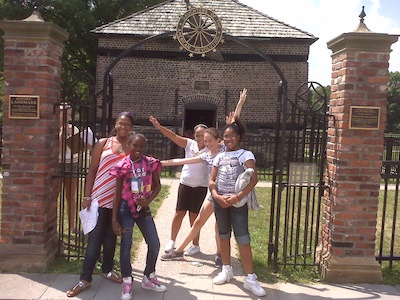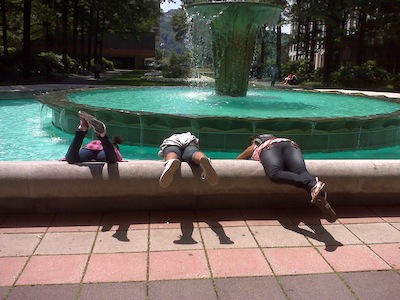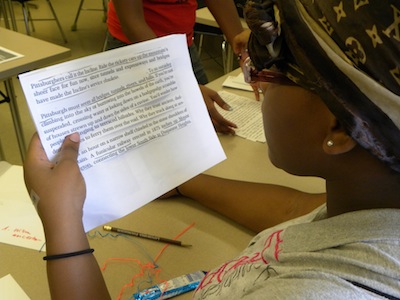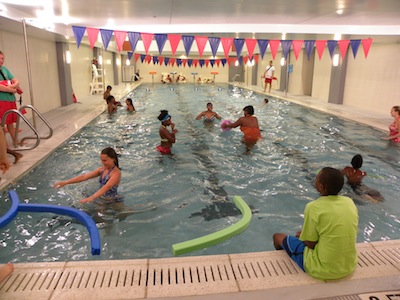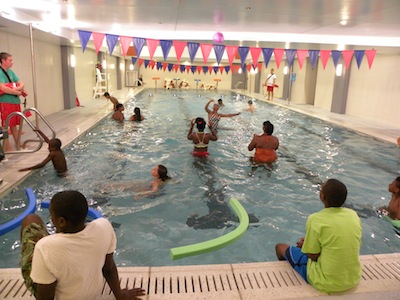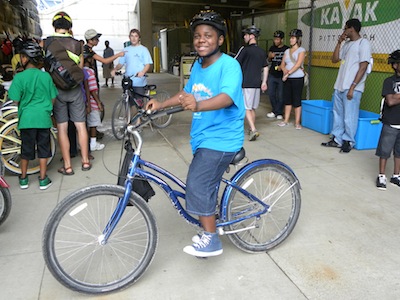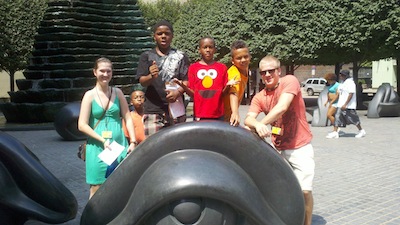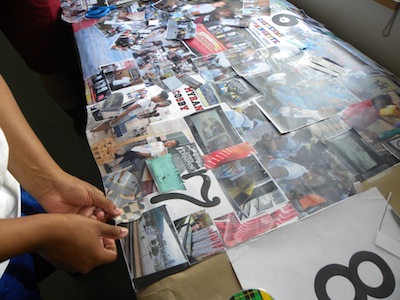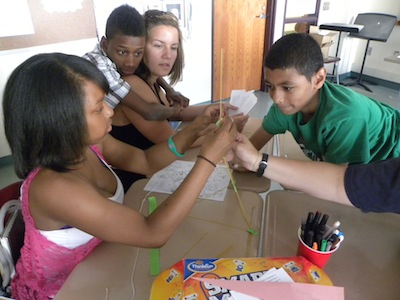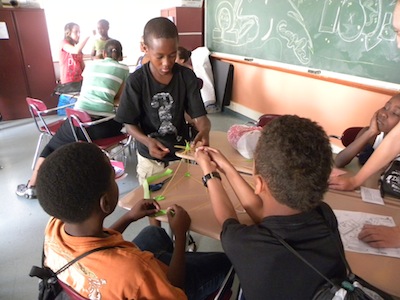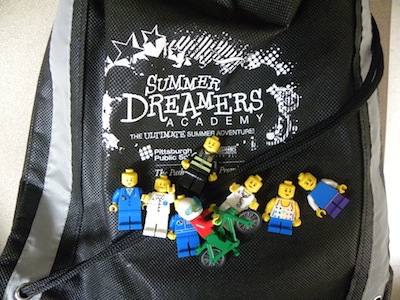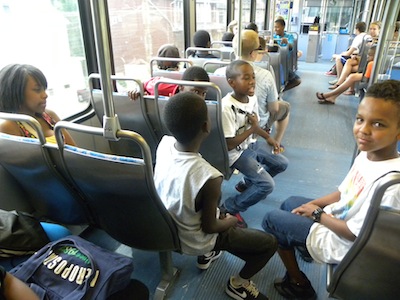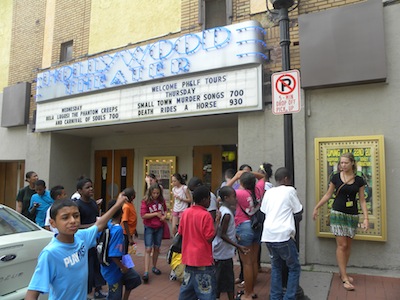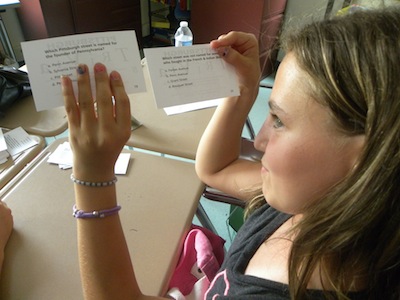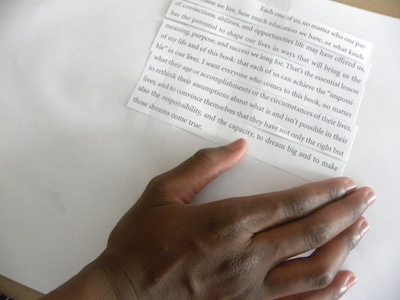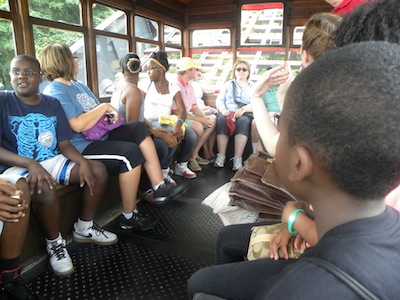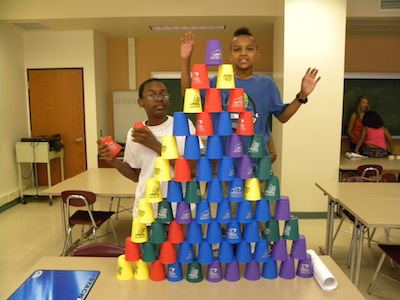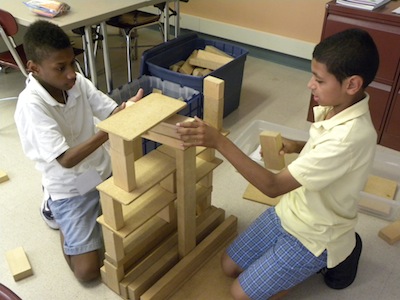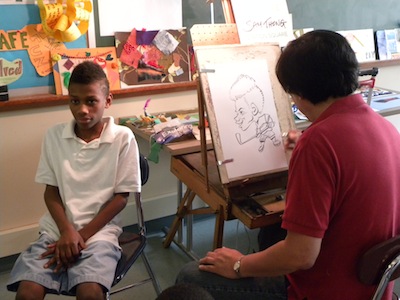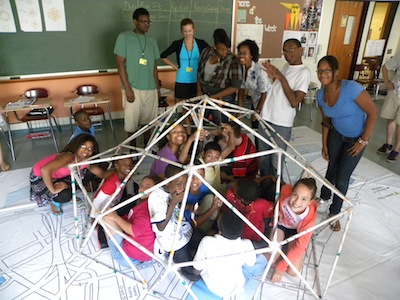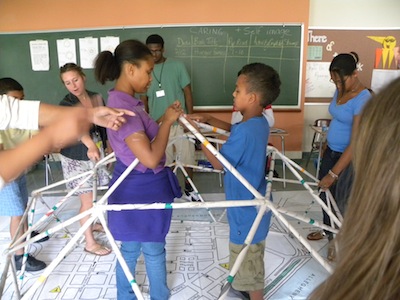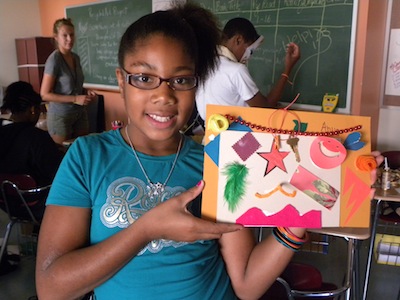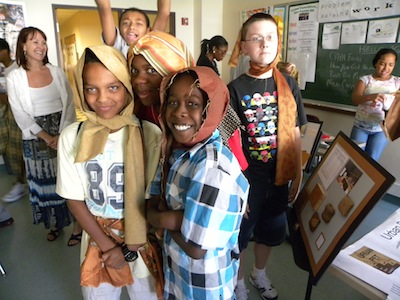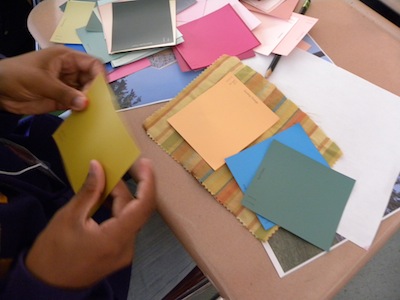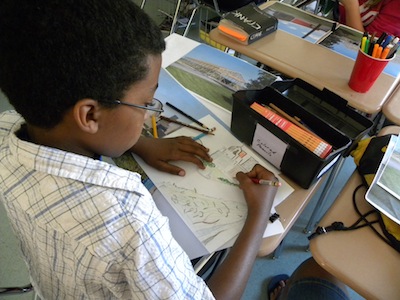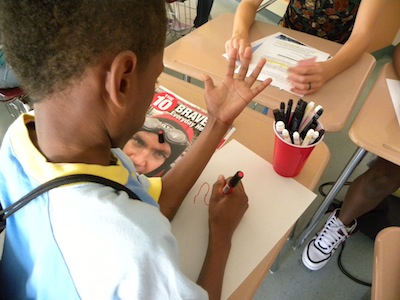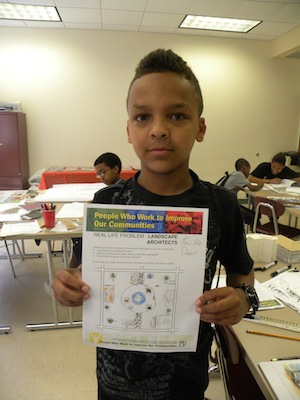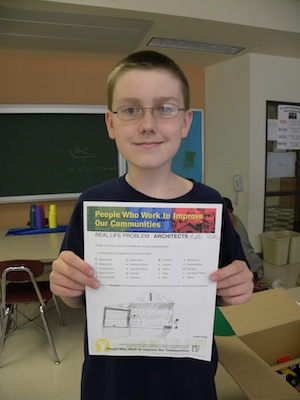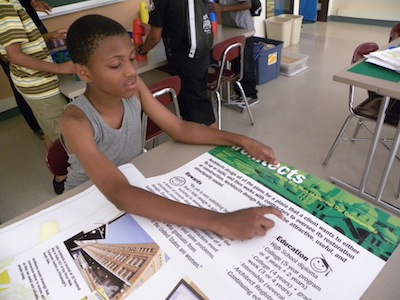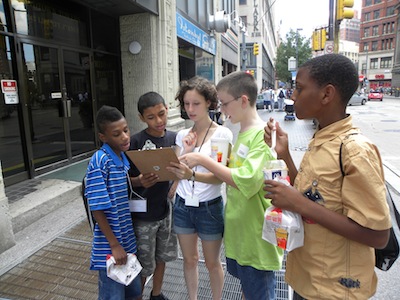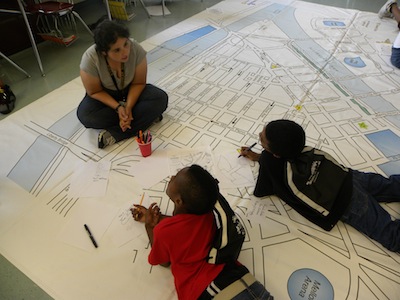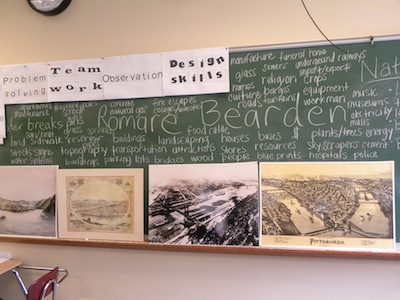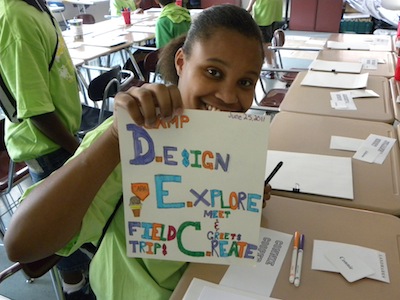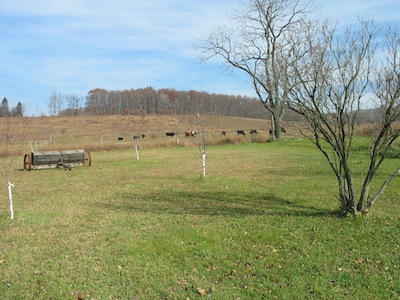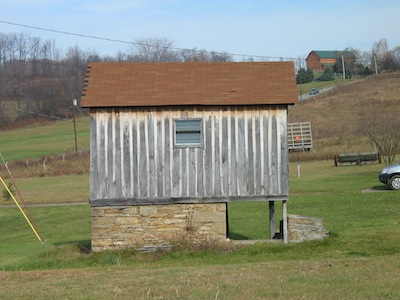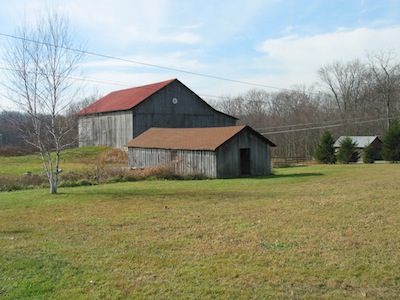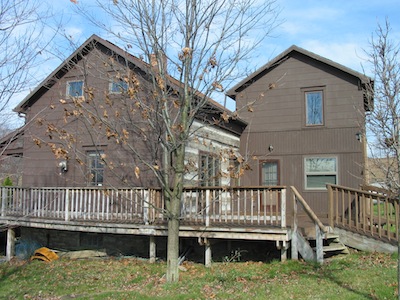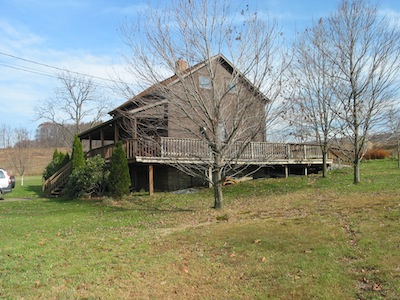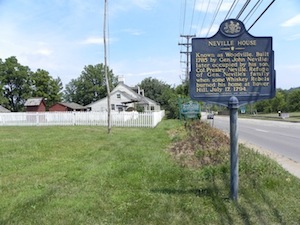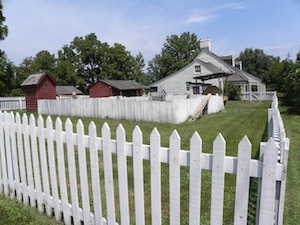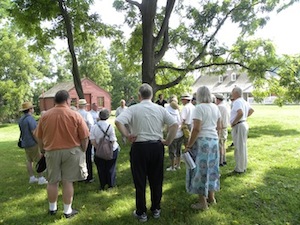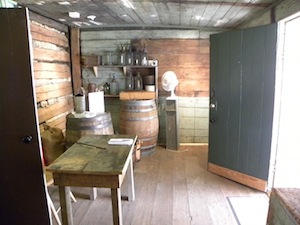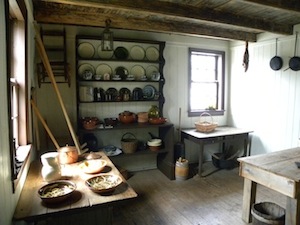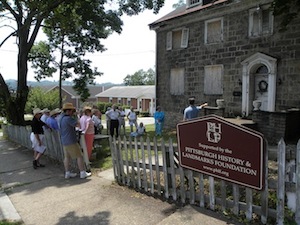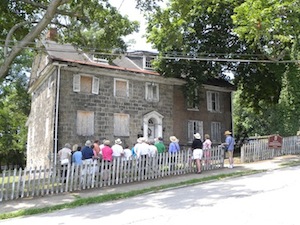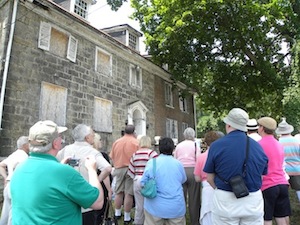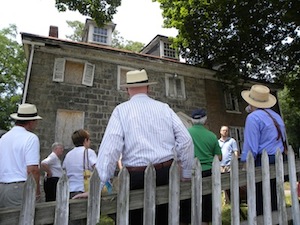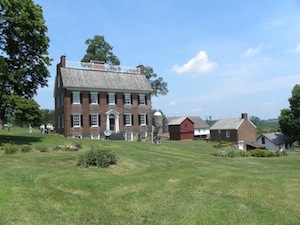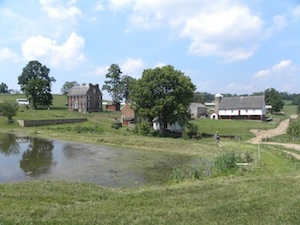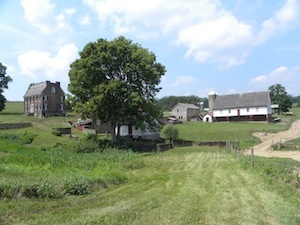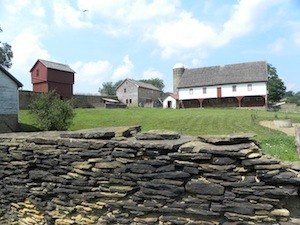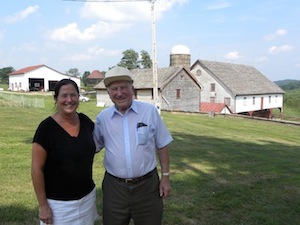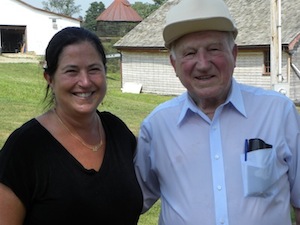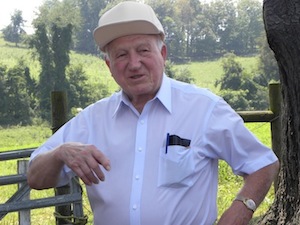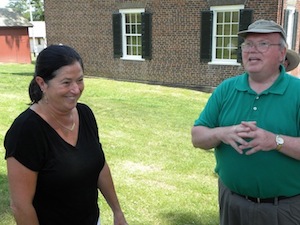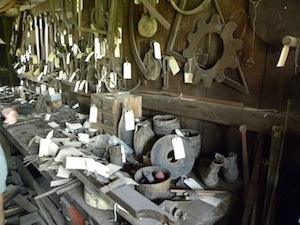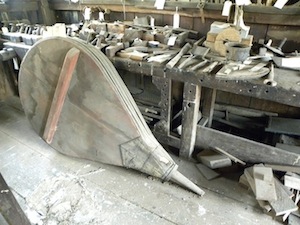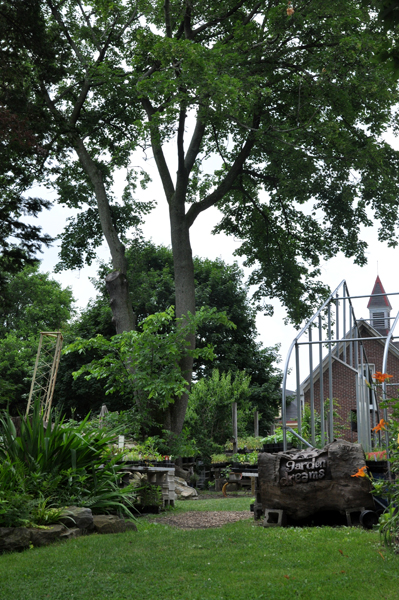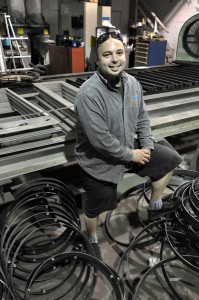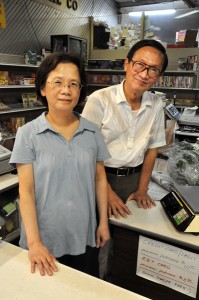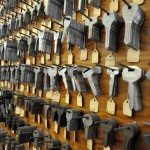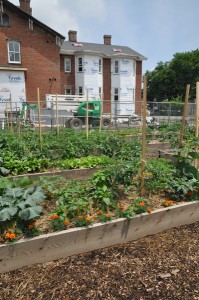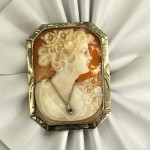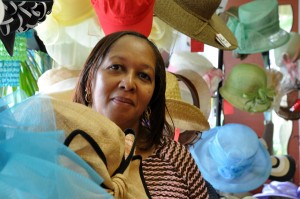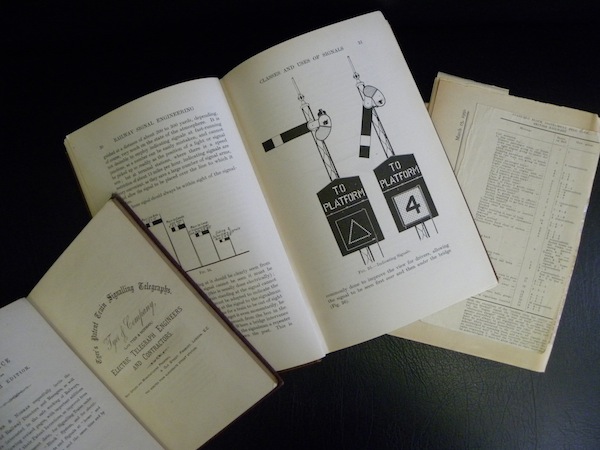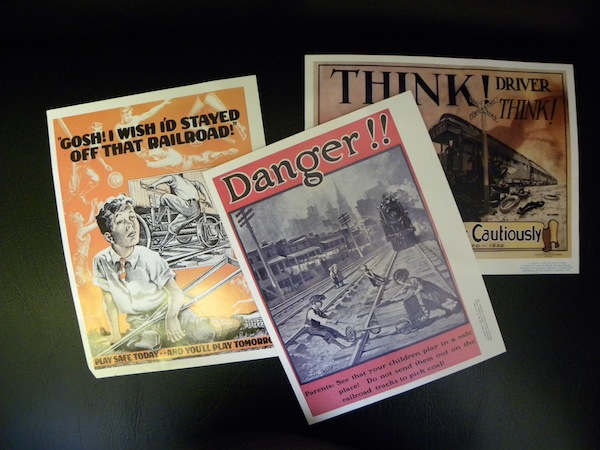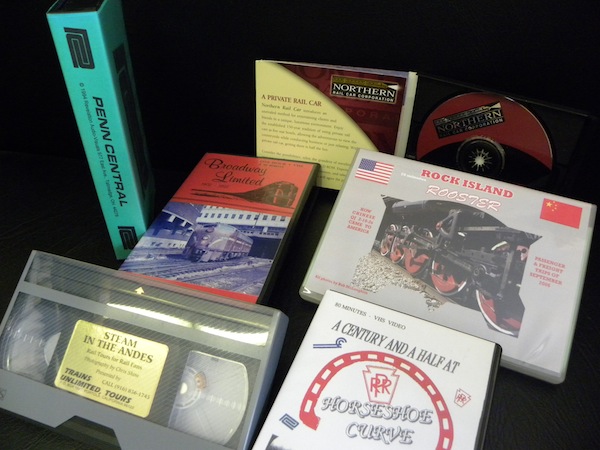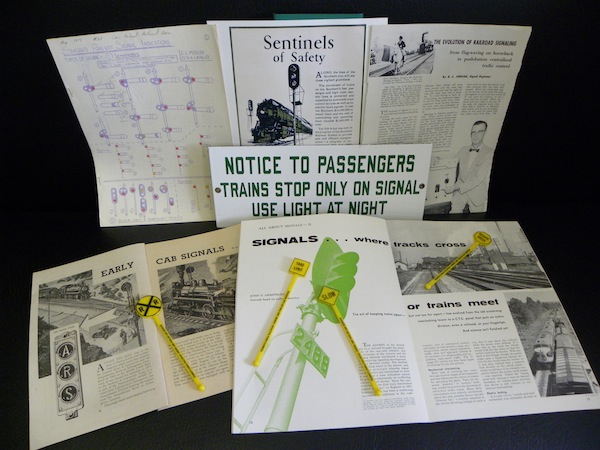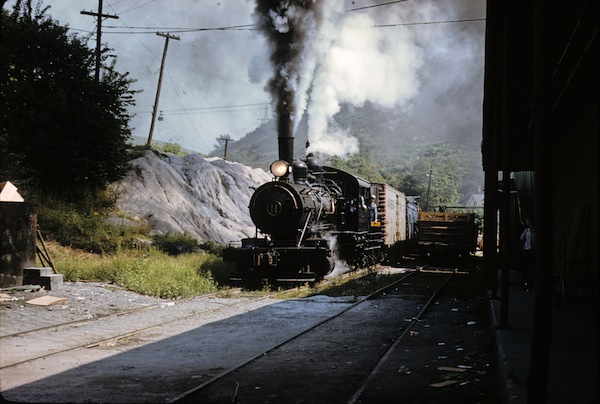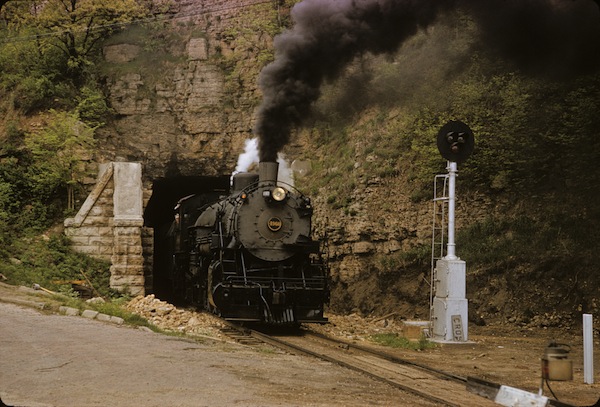
Archive: 2011
-
PHLF CampDEC for Pittsburgh Public Schools Summer Dreamers Academy
For the second summer, PHLF’s education staff and college interns are involving more than 20 middle school students in CampDEC (Design Explore Create). CampDEC is offered as an afternoon activity at CAPA, as part of the Pittsburgh Public Schools’ Summer Dreamers Academy. Twenty-three campers are exploring downtown Pittsburgh on foot, as they find answers to five Scavenger Hunts. In addition, they are swimming in the new indoor PNC YMCA pool on Fifth Avenue, biking along the North Shore, and kayaking in the Allegheny. Last week, they rode the T to Dormont to watch cartoons in the restored Hollywood Theater!
Campers have been introduced to the professions of architecture, engineering, urban planning, interior design, and landscape design so far, and one camper has written a letter to the Mayor asking him if it would be possible to build his design for “Piano Park.”
In terms of designing and creating, campers are creating a book, CampDEC Adventures 2011, and they are designing and building two models. One will show how a pedestrian bridge can be built on the historic Wabash Bridge piers, thus connecting downtown Pittsburgh and Station Square. The other shows how part of a parking lot at Station Square can be turned into a museum, picnic area, and garden.
Campers present their book and models on the last day of camp––August 10––at CAPA in the afternoon. If any PHLF members would like to come to see the presentations, you are welcome to do so. Please contact Louise Sturgess for details.
-
Historic Roaring Run Farm on the Market (SOLD)
SOLD
In 2004, PHLF accepted a donated preservation easement on Roaring Run Farm located at 276 Roaring Run Road in Champion, PA. Now, the owner of the 52-acre farm that dates back to the early 19th century is hoping a preservation-minded person will become its new owner.The property is located just a few miles from Seven Springs and the Donegal Exit of the Pennsylvania Turnpike, less than an hour from Pittsburgh. It includes a 1,600 square-foot house with three bedrooms, a separate double garage, a 40 x 50-foot bank barn and springhouse and is adjacent to a nature preserve and conservation district with an amazing view of the Laurel Highlands.
Persons interested in exploring the possibility of purchasing the farm are invited to contact Jeremiah T. O’Shea at 412-400-3371 or rorrunjto@yahoo.com. The asking price is $199,000.
-
Touring Western Pennsylvania’s Most Historic Homes
On July 23, a busload of PHLF members visited three of Western Pennsylvania’s most historic homes, all of which have survived to the present day due in part to PHLF’s help. The first stop was Woodville Plantation, the c. 1775 John and Presley Neville house in Collier Township, where PHLF Trustee Anne Genter, along with Rob Windhorst and Jim Galbraith of Neville House Associates, escorted the group on a tour of the beautifully restored and furnished Virginian vernacular house. Woodville is one of only 10 National Historic Landmarks in Allegheny County.
After lunch, the group traveled to Canonsburg where architect Jonathan Glance described the first phase of restoration plans for the John Roberts House, begun as a log house in 1798, and being transformed into an arts center by the Washington County Cultural Trust. The 1809 stone and 1840 brick portions of the house face North Central Avenue.
The trip concluded with a visit to “Plantation Plenty,” the Isaac Manchester Farm in Avella, Washington County, where Eugene Painter, a descendent of one of the members of the Lewis and Clark Expedition and Margie Manchester Pagliarulo, an eighth-generation descendent of Isaac Manchester, shared the rich history of the 215-year-old farm.
“It was great to show our friends how preservation tools like easements and planned gifts are helping to save these national treasures,” said Gift Planning and Easement Director Jack Miller. “Hopefully, our members will spread the word on what they learned and encourage more people to consider similar preservation strategies.”
Click on any of the pictures for a gallery slideshow of the tour.
-
Thank You Spring and Summer Interns
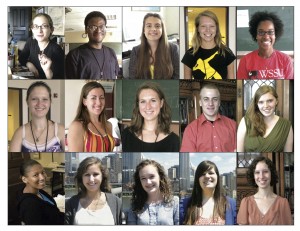
Since March, PHLF has involved 15 students (high school, college, and graduates) in its educational programs and preservation activities. As volunteers with PHLF, each student decides how many hours a week and what days he/she is able to help out. Once here, interns assist with school tours, workshops for teachers, research and archival assignments, and main street programs. And, if they enjoy being with students, they help out with CampDEC, a 20-day adventure with middle school students in the Pittsburgh Public School’s Summer Dreamers Academy. Thank you everyone for your help and effort!
As a result of their experiences, interns add to their portfolios and gain a new (or deeper) appreciation for Pittsburgh’s architecture and history and for the economic, social, and cultural benefits of historic preservation. Intern comments on the value of their experiences include the following:
- Julie Edwards: “PHLF has given me a deeper understanding of Pittsburgh’s extensive architectural heritage and a greater appreciation for the built environment.”
- Alyssa Malobicky: “Thank you for welcoming me back to PHLF again. The hands-on involvement in the day-to-day activities of PHLF teaches me so much. I appreciate all that PHLF does to keep Pittsburgh a special place.”
- Ashley Moore: “Through interning with PHLF, I have a new-found appreciation for Pittsburgh. It is amazing how evidence of the city’s changes was here long before I was and may be here long after I am gone.”
- Barrett Reiter: “My experiences with the educational, non-profit portion of PHLF have taught me that educating future generations is as important as preserving the accomplishments of those past. Without understanding and a personal connection to the built environment our unique history is too easily lost.”
- Shane Martin: “My time with PHLF has broadened my horizons on subjects ranging from historic preservation to urban design and the strenuous human effort put into the systems that hold our society together. I was fortunate to work alongside the very minds that ensure our city’s rich history and put forth my own efforts at planning the future.”
We thank the following 15 people (all pictured above) who volunteered their time and talent to PHLF:
- Lauren Borrelli, Penn State University (Architecture)
- Emily Bush, Miami University of Ohio (History/Journalism)
- Julie Edwards, Kent State University graduate (Interior Design)
- Michal Gould, University of Pittsburgh
- Stacy Litwinowicz, West Virginia University (Interior Design)
- Samantha Mabe, Clemson University (Architecture)
- Alyssa Malobicky, Virginia Tech (Landscape Architecture)
- Shane Martin, University of Pittsburgh (Urban Studies/Architectural Studies)
- Grace Meloy, University of Pittsburgh (Architectural Studies/Civil Engineering)
10. Ashley Moore, University of North Carolina graduate (Masters of Urban Design)
11. Barrett Reiter, University of Pittsburgh (History/Political Science/Historic Preservation)
12. Katherine Schmotzer, Baldwin High School
13. Emily VanBuren, Slippery Rock University––Masters (History)
14. Camden Yandel, Saint Vincent College (Graphic Design)
15. Sydney Zalewski, Carnegie Mellon University (Architecture/Photography)
To learn more about PHLF’s volunteer internship program click here.
-
The Insider Guide to Wilkinsburg
Anne Caffee | Wednesday, July 27, 2011Many in Wilkinsburg credit the Wilkinsburg Community Development Corporation for helping to drive this spirit of optimism. The WCDC was organized in 2007 to attract investors and entrepreneurs to its main commercial district on Penn Avenue.Its energetic and tenacious executive director, Tracey Evans, knows that Wilkinsburg’s success will be built brick by brick. “We are working hard to lay the right foundation for a more successful business district,” she says.Evans, a 25-year resident of Wilkinsburg, is in her fifth year as an elected member of the borough council, and chairs the Wilkinsburg Municipal Authority and Wilkinsburg Borough Commercial and Industrial Development Authority. She started out as a freelance set designer for Pittsburgh stage productions, and got involved as a volunteer in a number of local restoration projects. A graduate of Point Park University, her career in community revitalization took flight when she became the first executive director of the Wilkinsburg Community Development Corporation, which she helped found.
Now, in addition to overseeing the execution of a 6-year $1.8 million Neighborhood Partnership Plan for Wilkinsburg, funded by Tri-State Capital Bank and the Pennsylvania Department of Community and Economic Development, and developed with input from the borough, residents, and the business community, the WCDC is deep in the first phases of Streetscape Improvement Program to revamp the Penn Avenue corridor.
The first phase of the Program’s investment has provided tree pruning, 80 decorative streetscape banners, and locally fabricated trash receptacles designed by Technique Architectural Products, whose owner, Ray Appleby, is a CMU-trained sculptor. (His shop has outfitted Mad Mex locations with some cool metal work).
A recent grant through TreeVitalize Pittsburgh and the Borough of Wilkinsburg will put in place 500 new street trees, all to be planted by Nine Mile Run Watershed Association and volunteers on public property. A grant from Duquesne Light helped refurbish existing streetlights and create a well-lit and safer corridor while the Wilkinsburg Police Department has re-established a walking police presence along the business district.
“Our primary focus is crime and safety issues,” states Evans, “along with enforcement of building codes, loitering and littering laws. Our beautification work will also help attract business and investment back to Wilkinsburg.”
Some of Wilkinsburg’s old and architecturally gifted homes in the Hamnett Place neighborhood have been restored through the efforts of the Pittsburgh History and Landmarks Foundation (PHLF). Their Wilkinsburg redevelopment projects have successfully restored four homes in the Hamnett Place neighborhood; work on three more historic homes, and the two-building, 27-unit Crescent Apartment development, are scheduled for completion by the end of this year.
PHLF launched a housing resource center, and has cleaned and cleared vacant lots, “Initiatives taking place right now in Wilkinsburg total over $10 million,” says Michael Sriprasert, PHLF director of real estate.
Urban Homesteading: finding your match
For the socially progressive, frugal and urban-focused homeowner not afraid to get his/her hands dirty, Wilkinsburg is the right match: racially/ethnically diverse, close to the city and fuel-efficient: eight-minutes’ drive to downtown, close to urban programs and amenities and public transportation (access to the East Busway can get anyone downtown within 20 minutes) and within a fifteen-minute drive of four city neighborhoods, the Waterfront, and Monroeville.Wilkinsburg offers eye-poppingly affordable real estate for urban homesteaders and entrepreneurs who can spot an architectural gem beneath the overgrowth, and are willing to put in sweat equity to polish it up. (One business owner bought a parcel of land on a credit card).
Resident Chad Chalmers, an architect and member of the WCDC’s design committee,spotted a typical diamond-in-the-rough on an overgrown lot: six-bedroom, three-bath home with hardwood floors and 14 stained glass windows, which he and his wife Brigitte “fell in love with, and bought for a song,” and has spent five years restoring.
A new website provides up-to-date for rent/for sale listings in Wilkinsburg. The Borough and School District have developed a Tax Based Expansion Ordinance, which provides for tax compromise and tax abatement opportunities. Plenty of rehab and restoration programs stand ready to help homesteaders and investors who want in on the ground floor of an area poised for new growth.
But its biggest assets are long-standing businesses, some more than 30 years old, and a large number of robust and committed volunteers in its neighborhoods who care and dig in to run programs and restore neighborhoods.
Wilkinsburg Means Business
Downtown Wilkinsburg is five-block area along busy Penn Avenue (Pa. Route 8) and Wood Street that features unique businesses, residences, and historic and landmark architecture. What you won’t see are taverns and night clubs; Wilkinsburg has been legally dry since 1870. After the repeal of Prohibition in 1933 when liquor sales became a local option, residents voted to keep saloons out of Wilkinsburg. (Look for beer, tobacco, and soda, sold by the case on Penn Avenue’s Wilkinsburg Beverage Co.)
If you’re a fan of the Strip District, plan a visit to Pittsburgh Asian Market, a.k.a. Ou’s International, located on Penn Avenue, owned by Louis and Mai Ling Ou since 1981. Their large collection of specialty groceries and produce features hard-to-find items for Asian, Hispanic, and African-American menus.
Valley SalesValley Sales, a locksmith and key business on Penn Avenue in business since 1929, has an amazing wall display of hundreds of keys, both antique and modern. Owner Mary Blackburn remembers one customer who had just purchased a sweet 1967 Chevelle, and needed a key. She found one.
Matt’s Up-beat Records on Penn features current and hard-to-find soul, vintage Motown, hip hop, gospel, and jazz releases, along with DVDs and poster art.
Family-owned James Florist on Wood Street recently refurbished their store entrance and sign with a Pennsylvania “Main Street” façade grant. They’ve been providing posies for proms, weddings, funerals and family celebrations for more than a century. Step inside to see one of their favorite holiday store props: an antique horse-drawn sled in mint condition.Wilkinsburg has made a for itself in the urban farming/grow-your-own food movement with its new Hamnet Place Community Garden, leased to the community by PHLF (and each plot taken) and Garden Dreams, a certified organic farm and heirloom seed business.
Kenyon Jewlers, in business since 1924, is where the owner, Doug Duffus, does restoration on antique pieces, can custom create a wedding ring, and repair most anything brought in. In other words, he runs the place the way jewelry stores used to be run: with knowledgeable people and masters of their craft.
Leah Thomas opened a ladies’ boutique, A Woman’s Touch, on Penn Avenue seven years ago. Among fashionable church-going ladies in town, the sherbet-colored hats in her window never go out of style. This year, with a royal wedding spurring interest in stylish chapeaux, she had 150 to 200 new wholesale and custom-designed pieces on her racks. (*article in P-G:http://www.post-gazette.com/pg/11107/1139441-314.stm#ixzz1SIxp8woG*)Representative of Wilkinsburg’s historic pride in its churches, St. James Catholic Church, a gothic beauty almost 150 years old. has a long-standing commitment to social justice, and is a member of the Pittsburgh Interfaith Impact Network (it was one of its founding members), and is the only Wilkinsburg-based church among the PIIN membership.
To read more about Wilkinsburg businesses see the Featured Neighborhood on our home page this week and click on Live. Work. Play.Captions: Garden Dreams; Louis and Mai Ling Ou; Valley Sales; Community Garden; Kenyon Jewelers; Leah Thomas.
Photographs copyright Brian Cohen
-
Fairbanks Feature: STOP! LOOK! LISTEN!— THEN GO!
James D. Van Trump Library | Frank B. Fairbanks Transportation Archive | Fairbanks Features
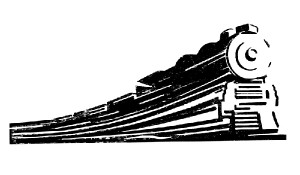 Showcasing a variety of materials located in the Frank B. Fairbanks Rail Transportation Archive
Showcasing a variety of materials located in the Frank B. Fairbanks Rail Transportation ArchiveNo. 10 Presentation
Fairbanks Feature: STOP! LOOK! LISTEN!— THEN GO!
Years ago, these three words––STOP! LOOK! LISTEN!–– were very common in schools across the country as safety lessons were taught on a regular basis. The burden for arriving safely was placed on the individual, as he or she went about on the public thoroughfares. Since railroad crossings and tracks were a common part of towns, this instruction for all ages or people was extremely necessary. Of course, not everyone paid attention to the seriousness of these rules, and many tragic accidents happened.
Even today, people are still playing the odds while sprinting across the tracks. Maybe it is time to re-teach some of these valuable safety lessons. Come to the Frank B. Fairbanks Rail Transportation Archive to see the following materials and so much more:
STOP!––Here are two books from our collection dealing with signals, and containing drawings, plans, and detailed yard layouts.
- Tyer’s Patent Train Signalling Telegraphs, by Tyer & Company, Electric Telegraph Engineers and Contractors, 4th edition, 1873
- Lewis’s Railway Signal Engineering (Mechanical), by J. H. Fraser, B. Sc., A.M. Inst. C. E., London, 1932
LOOK!––Here are three original safety posters from the 1920s and 30s.
LISTEN!
- “A Private Rail Car,” Northern Rail Car introduces an unrivaled method for entertaining clients in a luxurious environment.
- “Rock Island Rooster,” Muscatine, along the Upper Mississippi: the viewer can watch the rail line from atop the 1896 Government Bridge. The Railroad Development Corporation and Iowa Interstate Chairman Henry Posner III talk about how the project came to be and some of the challenges involved. These trips formed the centerpiece of “Riverway 2006,” celebrating the 150 years of the first bridge across the Mississippi.
- “Penn Central,” Big, Black, Busy––and Bankrupt––not the glory years.
- VCR tapes “Steam in the Andes,” “Broadway Limited,” and “Horseshoe Curve,” along with many others in our collection, provide rail history in audio and visual color spectacular.
THEN––Here are several articles and artifacts from the Fairbanks’ collection on signaling.
GO!––Here are two steam engine slides from our collection:
- 9/5/60: Olin Machieson Rail, photos by the Saltville RR Station, Saltville, Va. 2-8-0 East Tenn. & Western North Carolina engine No. 11; built 1892
- 5/20/61: West Portal Chicago Burlington Quincy Davenport to Dubuque Iowa, Iowa Chapter National Railway Historical Society, Steam Ramble
The Frank B. Fairbanks Rail Transportation Archive is open by appointment on Mondays, from 10:00 a.m. to 5:00 p.m. Use of the archive is free to PHLF members (one of the benefits!); non-members are assessed a $10 use fee.
The Archive is located on the fourth floor of The Landmarks Building at Station Square, in the offices of the Pittsburgh History & Landmarks Foundation.
To schedule an appointment, email the Librarian James Halttunen: James@phlf.org
-
Landmarks Organization to Set Up CMU Fellowship
Landmarks Organization to Set Up CMU Fellowship
By Tony LaRussa
PITTSBURGH TRIBUNE-REVIEW
Thursday, July 7, 2011A local foundation that helps finance the preservation of historic structures will use a $25,000 grant to set up a fellowship program in community and economic development at Carnegie Mellon University.
The Landmarks Community Capital Corp., a subsidiary of the Pittsburgh History and Landmarks Foundation, received the grant from the PNC Foundation. The program will be established this fall at CMU’s Heinz College School of Public Policy and Management.
The fellowship will provide $4,000 yearly stipends for students to conduct research on projects of interest to Landmarks in low- to moderate-income communities, said Karamagi Rujumba, a spokesman for the organization.
The organization’s president said the fellowships will provide students studying public policy with “a great learning experience.”
“Through the Landmarks fellowship, students will get a chance to step out of the classroom, learn about our approach to community and economic development, and make a direct impact on the work we’re doing in neighborhoods and urban centers,” said Michael Sriprasert, president of Landmarks Community Capital Corp.
Sy Holzer, PNC’s regional president for Western Pennsylvania, said the fellowship program will “bring a fresh perspective to development across the region.”
-
PHLF Celebrates Scholars at Luncheon
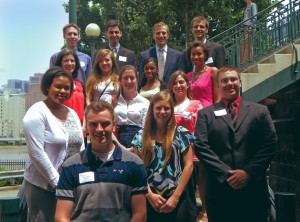 During a luncheon celebration on June 20, David Brashear, Chair of the Landmarks Scholarship Committee, welcomed scholarship winners and their parents and former recipients who were able to attend. This year’s winners are Jaela Wesley (Schenley), Christopher Guyan (South Fayette), Lisa Stabryla (Carrick), Anthony Chmura (North Hills), and Shane Fischbach (Allderdice).
During a luncheon celebration on June 20, David Brashear, Chair of the Landmarks Scholarship Committee, welcomed scholarship winners and their parents and former recipients who were able to attend. This year’s winners are Jaela Wesley (Schenley), Christopher Guyan (South Fayette), Lisa Stabryla (Carrick), Anthony Chmura (North Hills), and Shane Fischbach (Allderdice).In his remarks David said, “Know that you come from one of the very best places in the world. Know that you have grown up in a place where respectfulness and manners matter, where friendliness is a way of life, where humility is considered to be a positive trait, and where you are considered to be not only a member of the community but a member of a family.
“Pittsburgh has given you much that will help you become successful. You’ve received great educations, and you’ve grown up in a city and region rich in cultural and recreational diversions.
“We couldn’t be happier to welcome you to our scholarship community. We hope that you will come back and see us every year for this luncheon and we hope you will develop a lasting relationship with our organization and with Louise and her staff.”
Since 1999, PHLF has awarded 45 scholarships ($4,000 each, for book and tuition expenses only) to graduating high school students who have excelled academically, are active in their communities, and care deeply about the Pittsburgh region.
PHLF will be accepting Landmark Scholarship applications again in April 2012.

